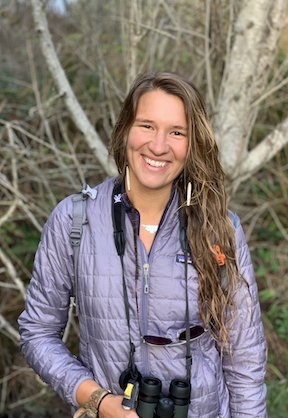Hanover Bald Eagle Blog # 17 - 2022
In partnership with Comcast Business and Pennsylvania Game Commission .
This last week the Hanover eaglets began taking larger chunks of food from their parents, and were even so brave as to approach a fish on their own.

Day by day the coordination and curiosity of the nestlings evolves, as do their flight feathers, which are emerging along their pterylae. I call this the Yoda Phase. The nestlings are still half-fluff, but soon their bodies will be covered in dark feathers.

As exemplified in the clip above, the Hanover family members are getting along swimmingly. The parents gently offer their kids morsels of fish, and the kids gently receive. The process is peaceful. However, once the nestlings leave the nest, that will all change.
The first year for a young eagle is a trying one. Dangers abound, including starvation, and they must quickly evolve scrappiness and a knack for problem-solving. Studies suggest that this learning process is a highly social one, whereby young eagles observe adults to learn the tricks of the trade.
Winter can be a particularly stressful time for young eagles living in cold regions, since waterways freeze and carcasses end up covered in snow. In these cases, eagles may either move in search of food, or form communal roosts that serve as information-sharing hotspots — or a combination of both. Winter roosts are critical for immature eagles. By observing the feeding choices of more experienced adults, youngsters can find food and learn how to socialize effectively, which includes intimidating other eagles into giving up their lunch. Roosts are so important to bald eagles during multiple stages of their life history, that eagles roosts themselves are protected under the Bald and Golden Eagle Protection Act of 1940. There is a “disturb” clause, which is explained on the National Eagle Registry site in the following words:
“Disturb means to agitate or bother a bald or golden eagle to a degree that causes, or is likely to cause, based on the best scientific information available, (1) injury to an eagle, (2) a decrease in its productivity, by substantially interfering with normal breeding, feeding, or sheltering behavior, or (3) nest abandonment, by substantially interfering with normal breeding, feeding, or sheltering behavior.” Disturbance at known roosts can be minimized or avoided with distance buffers, time of year access restrictions, and time of day restrictions.”
To view the number of documented roosts by state, visit this site.
In the Pacific Northwest, where bald eagles are as common as crows, conifer trees are often laden with them, especially at sites where salmon finish their spawning journeys. Bald eagles are well attuned to the timing of these mass salmon deaths. This is an example of knowledge a young eagle can glean from observing elders: Learning when and where to go to take advantage of this ephemeral food source.
Young bald eagles enter a “prolonged period of great exploration” lasting four years, as described by Buhler (2020). They reach sexual maturity around five years of age. Their movements during this non-breeding time are mostly opportunistic, meaning they go where food and weather will make their lives the easiest. Contrary to what we see in the Hanover nest right now, the dynamics between adults and immatures can be tense when a carcass or other food source is at stake, especially between unrelated individuals. First-year eagles are far less coordinated and accurate with their fishing techniques, in part because they are still learning how to fly. Therefore, to secure food, they employ a combination of clumsy flight, ground maneuvering, running, jumping, and, in group settings, tenacity.
Multiple studies suggest that large groups of bald eagles, whether at communal roosts or feeding sites, sort themselves into social hierarchies. The oldest, most experienced birds secure the best spots. Younger, less experienced birds must earn their place as they move through eaglehood.
During a study conducted at Swan Lake National Wildlife Refuge in north-central Missouri, a researcher observed immature eagles challenging adults more often than the reverse (adults challenging immatures). Young birds pursued adults in the air and attempted to displace them at feeding sites and perches. Adults did the same to immatures, but with less frequency. Surprisingly, Immature eagles’ displacements of adults were successful 223 out of 238 observed events, which is a whopping 94% success rate! However, this is just one study — I have personally seen many adult eagles dominate their younger colleagues. Personality is likely an important factor in the successes of antagonism at eagle hotspots.



Eagles fighting over harbor seal leftovers from a killer whale hunt that took place this week in the Salish Sea, WA (Source: April Ryan).
Fun Fact
Up to 500 individual eagles have been observed at a single roost in the Pacific Northwest!!!
(Keister et al 1983).
Sources
Buehler, D. A. (2020). Bald Eagle (Haliaeetus leucocephalus), version 1.0. In Birds of the World (A. F. Poole and F. B. Gill, Editors). Cornell Lab of Ornithology, Ithaca, NY, USA. https://doi.org/10.2173/bow.baleag.01
The Center for Conservation Biology. (2022). “National Eagle Roost Registry.”
https://ccbbirds.org/what-we-do/research/species-of-concern/species-of-concern-projects/national-eagle-roost-registry/#:~:text=The%20registry%20provides%20information%20needed,of%20the%20%E2%80%9Cdisturb%E2%80%9D%20clause.
Griffin, C. R. (1981). Interactive Behavior among Bald Eagles Wintering in North-Central Missouri. The Wilson Bulletin, 93(2), 259–264. http://www.jstor.org/stable/4161465

Raptor Ecology Specialist - Zoey Greenberg
RETURN TO HANOVER BALD EAGLE BLOGS
WATCH THE HANOVER BALD EAGLE LIVE CAMS
For over 20 years, HDOnTap has provided live streaming solutions to resorts, amusement parks, wildlife refuges and more. In addition to maintaining a network of over 400 live webcams, HDOnTap specializes in design and installation of remote, off-grid and otherwise challenging live streaming solutions. Contact press@hdontap.com for all media needs, including images and recordings.